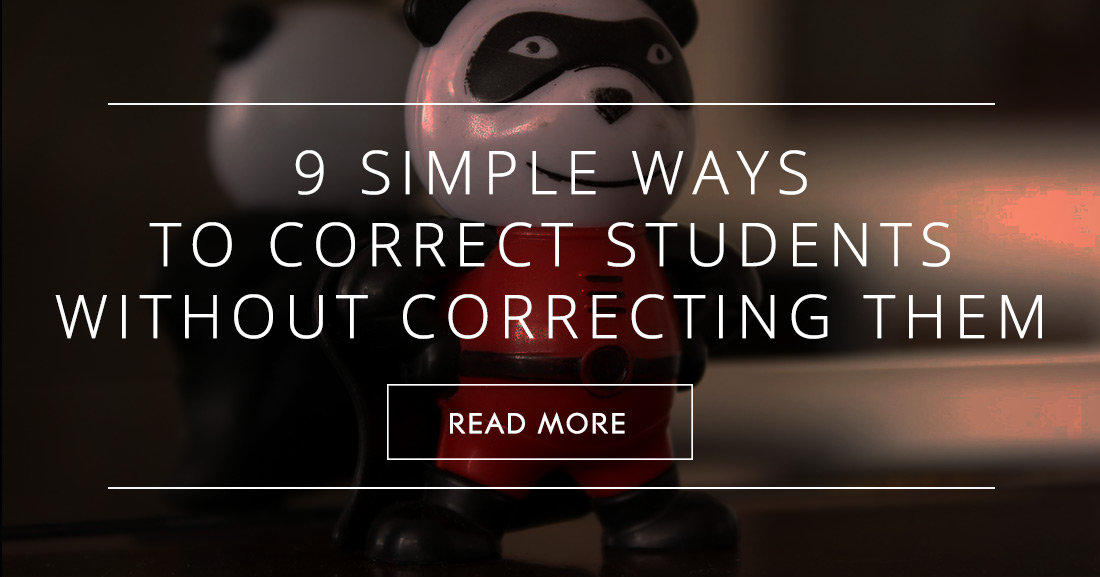How to Correct Mistakes


It is hard enough to get EFL students to practice speaking and writing without adding barriers. While it’s easy to make mistakes when learning new words, grammar, sentence structure, and pronunciation, it’s important to correct your students’ errors effectively, and at the same time sensitively. This will help them grow and develop their language skills and feel at the same time undeterred. Try correcting them in disguise with positive re-enforcers or a more passive style. It might not come naturally to you at first, but with a little practice, you will never tell a student she is wrong again!

If a student answers a question incorrectly or grossly mispronounces a word, fail to respond to him or her and rather stare blankly or with a raised eyebrow, like you heard no words. You will convey there was a failure in communication without correcting your body language cues, and those cues are actually a more powerful way of encouraging a second, third, and even fourth attempt for a right answer. The student will naturally want to try harder to communicate with you.
Do not tell her or him they are wrong, but ask if maybe there is another way (with the implication of better way) to answer your question or communicate. The question will trigger a thought process in which the student scans their mental thesaurus.
This question inspires recall of lessons taught, and your student will not think you are correcting them, only seeking a different answer based on your lesson plans. It will also trigger their brain to replace the incorrect word or usage with what you taught.
Do not correct your student, but immediately ask if anyone else has a different answer. Keep asking until someone gives you the right response. Positively respond to all of the participation, but very positively respond to the correct answer once you find it and stop asking for more answers. The final answer will remain in their heads as the best and the most correct.
Turn it around on your students! Poll who thinks the answer is correct. The correct answer will emerge, but the student who was wrong will have commiseration from classmates that voted for her answer, diffusing the culpability in a lighthearted way.
This phrase indicates that the student is on the right track, but is not quite conveying what he or she wants to communicate. He or she will keep trying and rephrase their words or try another grammatical construction naturally to attempt to explain. This is much more effective than “That is not how you say that” or other negative correction tools.
Nod in agreement with the student and then repeat what he or she is trying to say correctly. This shows it was said well enough to be understood and that the communication was relayed, but the correct pronunciation or grammar will stick in their mind. For example, if she asks, “I go to bathroom?” say, “Can I go to the bathroom? Yes you can go to the bathroom.”
If someone answers incorrectly, just ignore them and ask someone else until you receive the right response!
Do not correct wrong answers, but reward the right answer. This is the oldest teacher trick to inspire participation. Give candy, points, prizes, etc. if students answer you correctly, but do not even acknowledge wrong answers.
There is always a right time to correct a student’s mistakes. This can be done effectively – and sensitively. Use them as a source of understanding.
1 The first thing to ask yourself is: Is it a mistake or an error? A mistake is a brief incident or failure about something your student probably knows and will recognize themselves in time or if offered the chance. An Error is a different matter as these are made when a student hasn’t actually learned the work at that point or possibly just forgotten it. Never praise a mistake or error.
2 It’s preferable sometimes to leave the error correction for the end of the class so as not to demotivate your students.
If you think the students are sufficiently familiar with the activity, self-correction is good practice as it aids them to recognize their mistakes, gives them responsibility, and encourages critical thinking.
Don’t punish or embarrass them, point out the type of mistake they made in a simple, clear, and constructive manner. Be positive about it and provide correct examples.
Rather than singling out any student, make a list of errors that occur, then dedicate time to correct them all in one section of your lesson. You can either use those from the latest activity or from previous classes. Write them on the board and give a list to students.
With a little bit of practice, you can succeed at never correcting your students but always finding the right answer! You will notice higher participation in your activities as well as increased learning in your classroom by employing these techniques and always making wrong right.